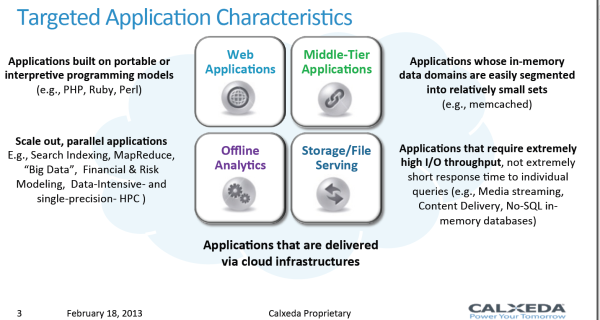Calxeda's ARM server tested
by Johan De Gelas on March 12, 2013 7:14 PM EST- Posted in
- IT Computing
- Arm
- Xeon
- Boston
- Calxeda
- server
- Enterprise CPUs
Finding a Good Fit
The previous benchmarks have shown that the first Calxeda server is not for the general IT market. As the slide below shows, Calxeda targets four kinds of workloads:
- Web applications
- Middle-tier applications
- Offline analytics
- Storage and file serving
For applications such as Memcache, the ECX-1000 1.4GHz lacks bandwidth and memory capacity. Once a Cortex-A15 based server is available, this can change quickly as performance will improve significantly and the amount of memory per CPU can be quadrupled to 16GB.
We did not test it yet, but our own experience tells us that the majority of the "scale out" applications are out of reach. Especially in the financial and risk modeling world, top performance and ultra low response times are prioritized.
Calxeda based Boston servers are already making inroads as storage servers. There is little doubt that a low power processing unit makes a lot of sense in a storage server.
That leaves the question whether or not Calxeda's latest server can make it in the web server and Content Delivery world. Calxeda claims 5W per server node, and no more than 250W for the complete server chassis with 24 server nodes. That's pretty cool, but currently there is another solution. Two octal-core Xeon E5 deliver no less 32 threads running on top of 16 very potent cores. Add a virtualization layer and you get tens of servers. The only limitation is typically the amount of RAM.
So assume you are a hosting provider. Which server do you use as your building block? You've got two choices:
The standard one, the Intel Xeon E5 server. The advantages are excellent performance whenever you need it, whether your application scales well with more threads or not. The Xeon can address up to 384GB of affordable RAM (16GB DIMMs). If that's not enough, 768GB is possible with more expensive LR-DIMMs.
Those are impressive specs, but what if most of your customers just want to host medium sized web sites, sites that are rich on content but rather low on processing requirements? Can the Boston Viridis server attract such users with a much lower power consumption? How far can you go with slicing and dicing the Xeon's monstruous performance into small virtual pieces? We decided to find out.











99 Comments
View All Comments
kfreund - Friday, March 15, 2013 - link
Keep in mind that this is VERY early in the life cycle, and therefore costs are artificially high due to low volumes. Ramp up the volumes, and the prices will come WAY down.wsw1982 - Wednesday, April 3, 2013 - link
Ja, IF they have high volume. But even if there is high volume, it's shared between different ARM suppliers and needless to say, the ATOM. How much can it be for one company?But the question is where the ARM get the volume? less performance, comparable power consumption, less performance/watt rational (not this kind extreme bias case ), less flexibility, less software support (stability), vendor specific (you can build a normal server, but can you build up a massive parallel cluster?), oh, don't forgot, more (much more) expensive. Which company will sacrifice themselves to beef up the market volume of the ARM server?
Sputnik_b - Thursday, March 14, 2013 - link
Hi Johan,Nice job benchmarking and analyzing the results. Our group at EPFL has recently done some work aimed at understanding the demands that scale-out workloads, such as web serving, place on processor architectures. Our findings very much agree with your benchmark conclusions for the Xeon/Calxeda pair. However, a key result of our work was that many-core processors (with dozens of simple cores per chip) are the sweet spot with regard to performance per TCO dollar. I encourage you to take a look at our work -- http://parsa.epfl.ch/~grot/pubs/SOP-TCO_IEEEMicro....
Please consider benchmarking a Tilera system to round-out your evaluation.
Best regards!
Sputnik_b - Thursday, March 14, 2013 - link
Sorry, bad URL in the post above. This should work: http://parsa.epfl.ch/~grot/pubs/SOP-TCO_IEEEMicro....aryonoco - Friday, March 15, 2013 - link
LWN.net has a very interesting write-up on a talk given by Facebook's Director of Capacity Engineering & Analysis on the future of ARM servers and how they see ARM servers fit in with their operation. I think it gives valuable insight on this topic.http://lwn.net/SubscriberLink/542518/bb5d5d3498359... (free link)
phoenix_rizzen - Friday, March 15, 2013 - link
ARM already has hardware virtualisation extensions. Linux-KVM has already been ported over to support it.Andys - Saturday, March 16, 2013 - link
Great article, finally good to see some realistic benchmarks run on the new ARM platform.But I feel that you screwed up in one regard: You should have tested the top Xoen CPU also - the E5-2690.
As you know from your own previous articles, Intel's top CPUs are also the most power efficient under full load, and the price would still be cheaper than the full loaded Calxeda box anyway.
an3000 - Monday, March 25, 2013 - link
It is a test using wrong software stack. Yes, I am not afraid to say that! Apache will never be used on such ARM servers. They are exact match for Memcached or Nginx or another set-get type services, like static data serving. Using Apache or LAMP stack is too much favorable for Xeon.What I would like to see is: Xeon server with max RAM non-virtualized running 4-8 (similar to core count) instances of Memcached/Nginx/lighttpd vs cluster of ARM cores doing the same light task. Measure performance and power usage.
wsw1982 - Wednesday, April 3, 2013 - link
My suggestion will be let them run one hard-disk to one hard-disk copy and measure the power usage:)